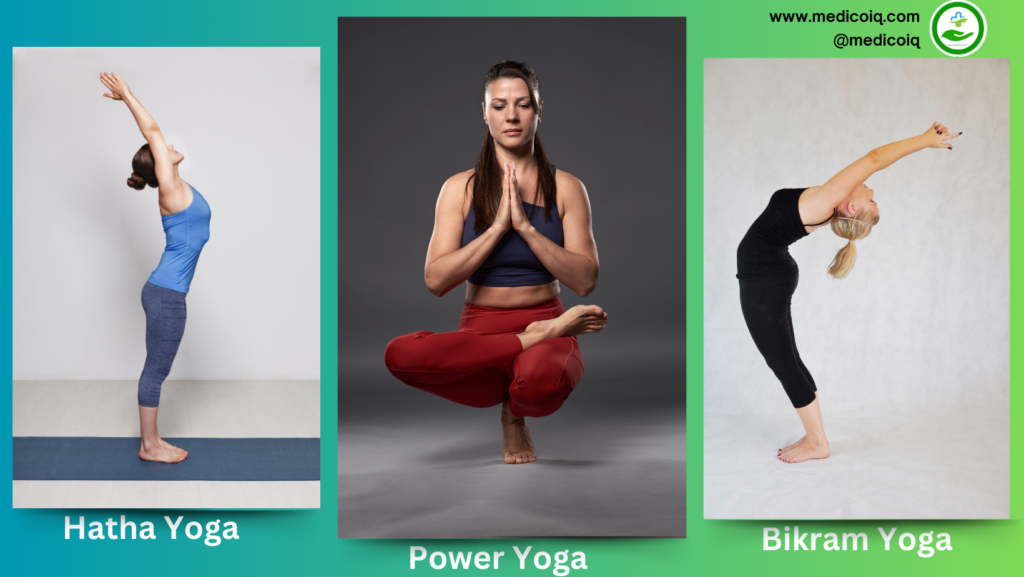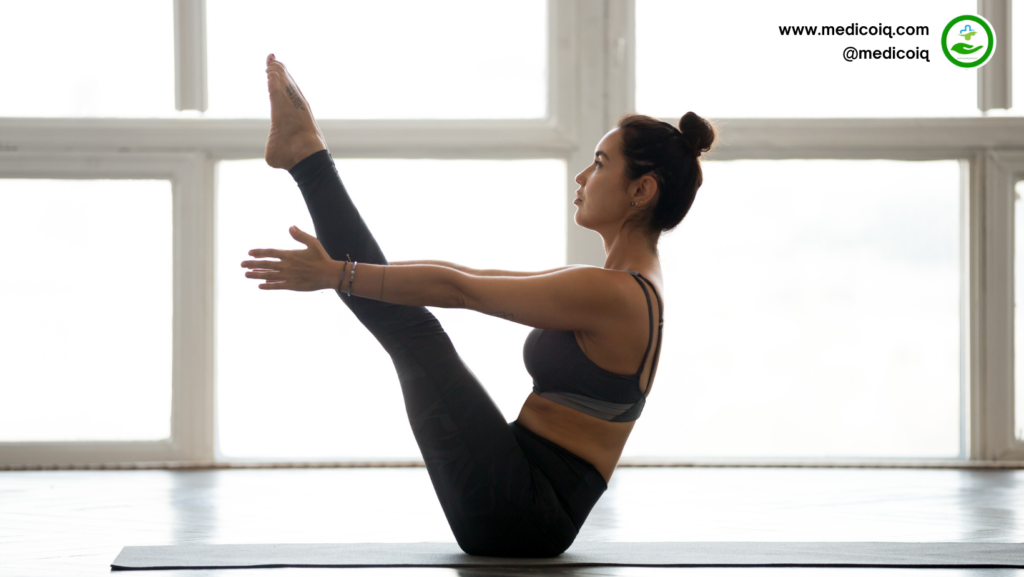Table of Contents
Benefits of Yoga For Weight Loss For Beginners
Yoga offers a multifaceted approach to weight loss that extends beyond physical exercise. It promotes mindfulness, reduces Stress, and improves body awareness, all of which can contribute to healthier eating habits and better weight management.
Additionally, specific yoga poses and sequences target core strength, flexibility, and metabolism, facilitating calorie burning and muscle toning. As a low-impact form of exercise, yoga is accessible to individuals of all fitness levels and can be tailored to suit individual needs and goals.
How Yoga Can Complement Other Weight Loss Strategies
Integrating yoga into a comprehensive weight loss plan can enhance overall results. When combined with cardiovascular exercise and a balanced diet, Yoga for weight loss for beginners helps create a sustainable lifestyle that promotes long-term weight management.
By fostering a mind-body connection, Yoga for weight loss or beginners encourages self-awareness and self-care, empowering individuals to make healthier choices and maintain consistency in their weight loss journey.
Whether practiced alone or alongside other forms of exercise, Yoga for weight loss for beginners offers a holistic approach to achieving and maintaining a healthy weight.
You Also Like Somatic Yoga and Its Benefits

Understanding Yoga for Weight Loss
How Yoga Can Aid in Weight Loss:
Yoga offers a holistic approach to weight loss by addressing physical, mental, and emotional aspects of wellness. Firstly, the physical practice of Yoga for weight loss for beginners involves a variety of poses and movements that engage muscles, increase flexibility, and improve cardiovascular health.
These movements, combined with conscious breathing techniques, elevate heart rate and promote calorie burning, aiding in weight loss.
Moreover, yoga fosters mindfulness and self-awareness, which can positively impact eating behaviors and habits. By practicing mindfulness during yoga sessions, individuals become more attuned to their bodies’ hunger and satiety cues, leading to healthier food choices and portion control.
Additionally, Yoga for weight loss for beginners reduces stress levels by activating the parasympathetic nervous system, which can help prevent stress-induced overeating or emotional eating. Furthermore, certain yoga poses specifically target areas of the body prone to storing excess fat, such as the abdomen, thighs, and hips.
These poses not only strengthen and tone muscles but also stimulate the metabolism, contributing to fat loss and improved body composition over time.
Different Yoga Styles Suitable for Weight Loss:

Key Poses Yoga For Weight Loss For Beginners
Yoga for weight loss for beginners offers a diverse range of poses that engage multiple muscle groups simultaneously, promoting strength, flexibility, and calorie burning.
Dynamic sequences and poses that require balance or engage large muscle groups tend to be particularly effective for weight loss. These poses not only increase heart rate and metabolism but also build lean muscle mass, which contributes to long-term fat loss and improved body composition.
1. Sun Salutations (Surya Namaskar):
Sun Salutations are a series of dynamic poses performed in a flowing sequence. They involve movements such as forward bends, lunges, and downward-facing dogs, which engage the entire body and promote flexibility, strength, and cardiovascular health. Sun Salutations are an effective warm-up or standalone practice for increasing calorie burn and energizing the body.
2. Warrior Poses (Virabhadrasana):
Warrior poses, including Warrior I, Warrior II, and Warrior III, strengthen the legs, core, and upper body while improving balance and stability. These poses also stretch the hips and groin, releasing tension and promoting better posture. Warrior poses build endurance and mental focus, making them valuable additions to a weight-loss yoga routine.

3. Chair Pose (Utkatasana)
The chair pose is a powerful lower-body strengthening pose that engages the quadriceps, glutes, and core muscles. It also improves balance and stamina while increasing heart rate and calorie expenditure. Chair pose tones the thighs and buttocks and can help individuals build the strength and endurance needed for more advanced yoga poses.
4. Boat Pose (Navasana):
The boat pose targets the abdominal muscles while also strengthening the hip flexors and lower back. By engaging the core muscles, the Boat pose improves digestion, enhances posture, and tones the abdominal region. It is an effective pose for building core strength and promoting overall stability and balance.

5. Plank Pose (Phalakasana):
The plank pose is a full-body strengthening pose that targets the core, arms, shoulders, and legs. Holding the body in a straight line from head to heels engages multiple muscle groups simultaneously, promoting muscle endurance and calorie burn. Plank pose also improves posture and stability, making it a valuable addition to any weight loss yoga routine.
Incorporating these key poses into a regular yoga for weight loss for beginners practice can enhance weight loss efforts by increasing calorie burn, building muscle strength, and improving overall fitness levels. Whether practiced individually or as part of a sequence, these poses offer numerous benefits for physical and mental well-being.

Yoga Sequences for Weight Loss
Yoga Sequences Designed Specifically for Weight Loss
1. Dynamic Flow Sequence:
Begin with Sun Salutations (Surya Namaskar) to warm up the body and increase heart rate. Follow with a series of dynamic poses such as Warrior poses (Virabhadrasana), Chair pose (Utkatasana), and High Plank to Low Plank transitions. Include balancing poses like Tree pose (Vrksasana) and Boat pose (Navasana) to challenge stability and engage core muscles. Finish with cooling poses such as Forward Fold (Uttanasana) and Seated Forward Bend (Paschimottanasana) to stretch and relax the body.
2. Core-Centric Sequence:
Focus on poses that target the core muscles, such as the Boat pose (Navasana), Plank pose (Phalakasana), and Side Plank (Vasisthasana). Incorporate dynamic movements like bicycle crunches and leg lifts to engage the abdominal muscles further. The transition between poses smoothly to maintain a steady flow and intensity throughout the sequence.
How to Structure a Yoga Session for Maximum Effectiveness:
1. Warm-Up:
Start with gentle warm-up poses such as Cat-Cow (Marjaryasana-Bitilasana) and Downward-Facing Dog (Adho Mukha Svanasana) to loosen up the muscles and joints. Gradually increase intensity with Sun Salutations or other dynamic movements to prepare the body for more challenging poses.

2. Main Sequence:
Incorporate a combination of strength-building, flexibility-enhancing, and calorie-burning poses into the main part of the session. Focus on flowing sequences that seamlessly transition from one pose to the next, maintaining a steady rhythm and breath awareness throughout. Include a variety of poses targeting different muscle groups to ensure a well-rounded practice.
3. Cool Down and Relaxation:
Conclude the session with cooling poses and relaxation techniques to help the body unwind and release tension. Gentle stretches such as Child’s Pose (Balasana), Bridge pose (Setu Bandhasana), and Supine Twist (Supta Matsyendrasana) can promote flexibility and ease muscle soreness. End with a few minutes of Savasana (Corpse Pose) to fully relax the body and mind.
By structuring Yoga for weight loss for beginners sessions with a balance of warm-up, main sequence, and cool-down components, practitioners can maximize the effectiveness of their practice for weight loss. Consistency and dedication to regular practice are key to achieving desired results over time.

Incorporating Yoga into Your Weight Loss Routine
Tips for Integrating Yoga into Your Daily or Weekly Exercise Routine
Suggestions for Finding the Right Yoga Class or Instructor
Diet and Lifestyle Tips of Yoga For Weight Loss For Beginners
Importance of a Balanced Diet and Healthy Lifestyle Habits Alongside Yoga Practice:
While yoga offers numerous benefits for weight loss, it’s essential to complement your practice with a balanced diet and healthy lifestyle habits. A nutritious diet provides the fuel your body needs to support physical activity, promote muscle growth, and maintain overall health.
Pairing yoga with healthy eating habits enhances the effectiveness of your weight loss efforts and promotes long-term success. Additionally, adopting healthy lifestyle habits such as staying hydrated, getting enough Sleep, and managing stress levels further support your journey to a healthier weight and lifestyle.

Tips for Maintaining a Healthy Diet and Lifestyle for Sustainable Weight Loss

Conclusion Of Yoga For Weight Loss For Beginners
Recap of the Benefits of Yoga for Weight Loss
Throughout this exploration, we’ve uncovered the myriad benefits of yoga for weight loss for beginners. Yoga offers a holistic approach to wellness, combining physical exercise, mindfulness, and stress reduction to support healthy weight management.
Through dynamic poses, mindful movement, and breath awareness, yoga promotes calorie burning, muscle toning, and improved metabolism. Additionally, yoga fosters a strong mind-body connection, empowering individuals to make healthier choices, manage Stress, and cultivate self-awareness.
Encouragement for Readers to Incorporate Yoga into Their Weight Loss Journey for Improved Physical and Mental Well-Being
As you embark on your weight loss journey, consider integrating yoga into your routine for enhanced physical and mental well-being. Whether you’re seeking to shed excess pounds, tone muscles, or improve overall fitness, Yoga for weight loss for beginners offers a versatile and effective approach to achieving your goals.
By committing to regularYoga for weight loss for beginners practice, you’ll not only reap the physical benefits of increased strength, flexibility, and endurance but also experience profound mental and emotional transformation.
FAQS of Yoga For Weight Loss For Beginners
What types of yoga are suitable for beginners aiming for weight loss?
Beginners can start with gentle styles like Hatha or Vinyasa, gradually incorporating more challenging poses as they progress.
How frequently should beginners practice yoga for weight loss?
Aim for at least 3-4 sessions per week to see noticeable results. Consistency is key in achieving weight loss goals.
Is yoga alone sufficient for beginners to lose weight?
While yoga offers numerous benefits including improved flexibility and stress reduction, combining it with a balanced diet and regular cardio exercise can enhance weight loss efforts.
Are there specific yoga poses beginners should focus on for weight loss?
Poses like downward-facing dog, warrior poses, and sun salutations can help build strength and burn calories, making them ideal for beginners aiming for weight loss.
How long does it take for beginners to see weight loss results from yoga?
Results vary depending on factors like diet, frequency of practice, and individual body composition. However, many beginners start noticing positive changes in their body and energy levels within a few weeks of consistent practice.



